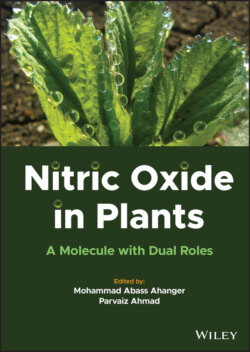Читать книгу Nitric Oxide in Plants - Группа авторов - Страница 32
2.6 NO Modulation and Regulation by Osmolytes Under Abiotic Stress
ОглавлениеPlants are sessile and confined to particular site where seed germinates and plant grow. From germination till new seed development, plants withstand a fluctuating and heterogeneous environment. Among several abiotic factors, water stress subsists in various forms, along with salt, drought and temperature stress. These stresses have negative impact on cellular and developmental processes and also impose high osmotic stress (Bajguz 2014; Brouquisse 2019).
To tolerate hazardous osmotic and oxidative stress, one universal method acquired by plants is the synthesis of “compatible solutes” or “osmolytes,” which act by driving a gradient for the uptake of water and play an important part in maintaining the turgor pressure. Osmolytes are low molecular weight, nontoxic, highly soluble organic compounds that are utilized by plant cells to sustain turgor pressure by osmotic adjustments. They also help in redox metabolism by eliminating excess levels of ROS and reinstating the balance of cellular redox. Osmotic adjustment has been characterized as the central dogma in stress physiology. Osmoprotective compounds are diverse in nature and include amino acids (glycine betaine, proectoine, pipecolic acid), simple sugars (glucose and fructose), complex sugars (raffinose, fructans), and sulfonium compounds.
Salinity as a condition has some of the most diverse consequences for plant development due to its deleterious effect on the regulation of ions and osmotic balance. During salt stress, NO increases the action of antioxidant enzymes and also protect plants by elevating the levels of ascorbate and glutathione (antioxidant metabolites) and proline/soluble sugar (osmolytes) in the cytoplasm and other organelles. Improved accumulation of soluble sugars and soluble proteins in reaction to saline stress was documented by Amini and Ehsanpour (2005) in Nitraria tangutorum. Proline is one of the most important osmolytes that facilitates cell osmoregulation under salinity. It also has a shielding effect on photosynthetic machinery, acts as energy storage, and protects the cell from oxidative damage. Under salt stress, soluble proteins play an important part in osmotic adjustment and can provide a storage form (nitrate) of N2. The elevation in soluble protein content may be due to the enhanced production of particular stress-related proteins. Soluble sugars act as essential osmolytes to retain the cell homeostasis (Ahmad et al. 2016; Khator and Shekhawat 2019; Shams et al. 2019). Exogenous application of NO has also been known to induce the P5CS1gene encoding δ1-pyrroline-5-carboxylate synthetase, a key enzyme involved in proline synthesis. Exogenous application of NO leads to accumulation of proline, total soluble proteins, and sugars, which may improve salt tolerance of cells through osmotic regulation (Amini and Ehsanpour 2005; Khator and Shekhawat 2019). As a result, the augmented osmotic pressure in the cells improves water uptake, and consequently plant growth and biomass yield. Furthermore, various studies have revealed that in conditions of high salinity, plant cells may experience an imbalance of the inner cellular ions, thus causing osmotic stress and ion toxicity. Increasing Na+ elimination and K+ absorption, thus sustaining the optimal ratio of K+/Na+, is essential to endure salt stress (Amini and Ehsanpour 2005; Ahmad et al. 2016; Shams et al. 2019).
During periods of biological strain in plants, the production of signaling molecules (NO, H2S, and CO) has been observed. There are several reports indicating that NO prompts the development of an essential osmolyte like proline in wheat (Wang et al. 2019), cabbage, and rye grass (Lou et al. 2015) by enhancing the expression of P5C5and down regulating the proDH genes. It has been suggested that NO enhances the accumulation of osmolytes, e.g. proline and glycine betaine, in tomato during cadmium stress when applied externally. Additionally, NO application confines the uptake of Cd and boosts the buildup of nutrients in various portions of tomato plants (Ahmad et al. 2018). The activities of SOD, catalase, ascorbate peroxidase, glutathione reductase, monodehydroascorbate reductase, dehydroascorbate reductase (antioxidant enzymes), and other enzymatic activities of the ascorbate–glutathione cycle are also improved by the application of nitric oxide (Kaya et al. 2020a).
Water deficiency is one of the leading reasons for low agri-productivity and addition of NO has been shown to have an ameliorating effect during water stress in wheat. It has been proposed that SNP applied to wheat seedlings under polyethylene glycol-induced drought stress led to enhanced plantlet growth and high relative water contents and lessened the oxidative destruction to the seedlings under stress (Tian and Lei 2006). In this case, whether NO is protective or toxic to plants was found to be concentration dependent. A low concentration (0.2 mM) inhibits the loss of water, lowers the content of H2O2, and leads to higher antioxidative enzyme activity, which supports the wheat seedling growth, while high concentrations (2 mM) of SNP have the opposite effect.
